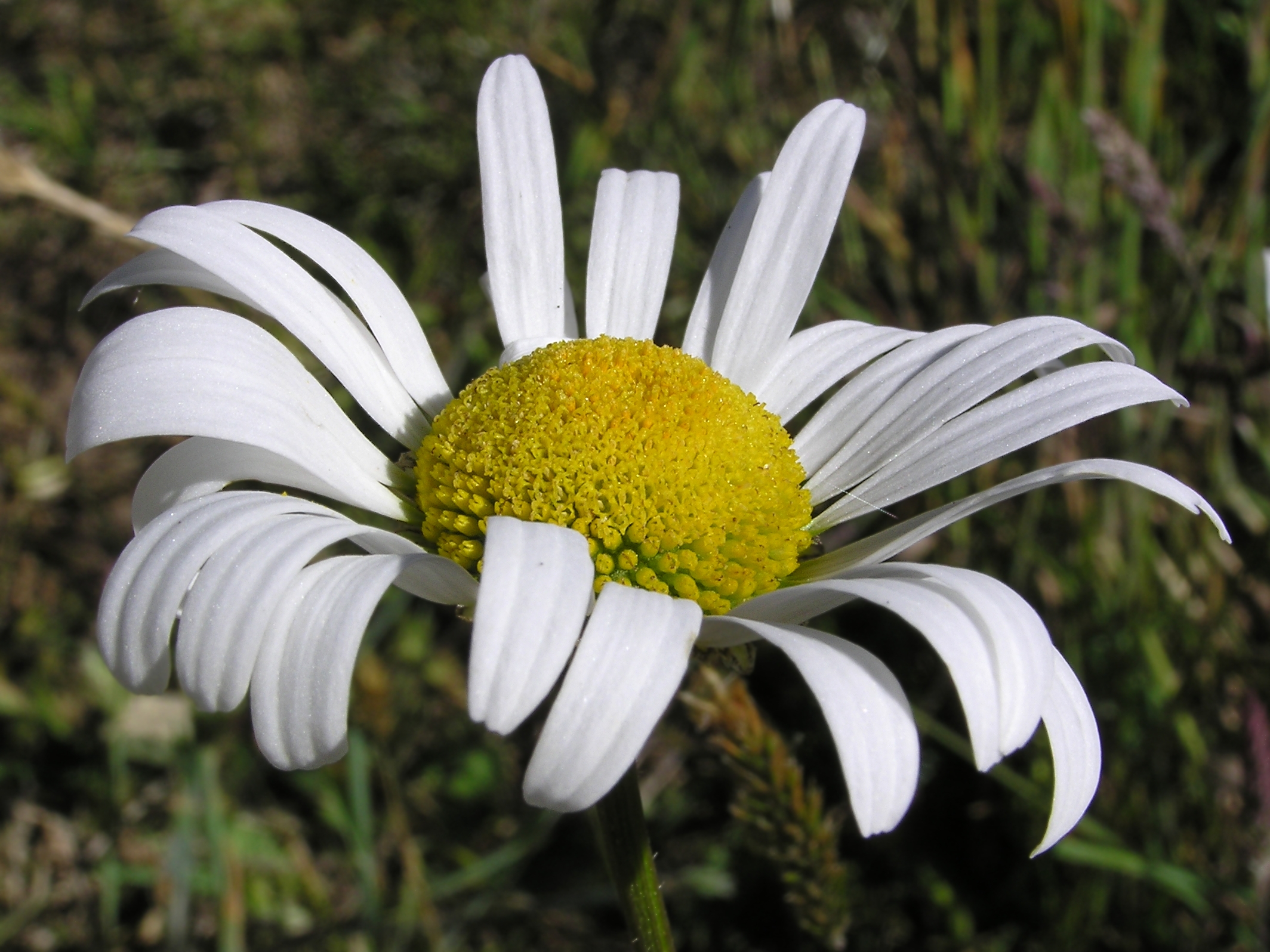- Leucanthemum
Taxobox
name = "Leucanthemum"

image_width = 260px
image_caption = "Leucanthemum vulgare "
regnum =Plant ae
divisio = Magnoliophyta
classis =Magnoliopsida
ordo =Asterales
familia =Asteraceae
subfamilia =Asteroideae
tribus =Anthemideae
genus = "Leucanthemum"
genus_authority = Mill.,1754
type_species = "Leucanthemum vulgare " Lam.
subdivision_ranks = Species
subdivision = See text.
synonyms = "Osmitopsis" Cass."Leucanthemum" is a genus of about 70 flowering plants from the sunflower family (
Asteraceae ). The name "Leucanthemum" derives from the Greek words "leukos", "white," and "anthemon", "flower". It occurs in Europe, Northern Africa and the temperate regions of Asia. Many species have been introduced into America, and even Australia and New Zealand.It consists of clumped rhizomatous perennials, or rarely annuals, growing to a height of 30cm - 1 m. They were split from the genus "
Chrysanthemum ", because they are not aromatic and their leaves lack grayish-white hairs. The herbaceous, fast-growing stem is mostly unbranched and sprouts laterally from a creeping rootstock. The stem is glabrous or hairy below. The alternate leaves are cauline. The margins are singly to doubly toothed.The daisy-like
flower heads are terminal, mostly solitary, such as in the Shasta Daisy ("Leucanthemum" x "superbum"), and rarely a few incorymbs , such as in the Oxyeye Daisy ("Leucanthemum vulgare "). They vary in diameter from 3 to 8 cm. The flowers are pedunculate with involucral bracts and a flat or convex receptacle. They form 2 to 4 whorls. There are about twenty ligulate, white or pinkish ray florets. These are usually female, rarely bisexual. The numerous, tubular, yellow disc florets are bisexual.This genus has an abundant production of 10-ribbed achenes (flat
seed s) withmucilaginous cells . The pappus is usually absent, or just a small corona or auricle. Species of this genus also spread vegetatively by rooting underground stems."Leucanthemum" species are used as food plants by the
larva e of someLepidoptera species including the bucculatricid leaf-miners "Bucculatrix argentisignella " (which feeds exclusively on "Leucanthemum vulgare "), "Bucculatrix leucanthemella " and "Bucculatrix nigricomella " (feeds exclusively on "Leucanthemum vulgare ") and also "Hypercompe indecisa".Most species are considered obnoxious
weed s. The Shasta Daisy ("Leucanthemum" x "superbum") is an ornamental with many cultivars, ideal for cut flowers, such as "Aglaia", "Becky", "Esther Read", "Wirral Pride", "Wirral Supreme", "Tinkerbell" and "Snow Lady".Gallery
Species
* "
Leucanthemum adustum "
* "Leucanthemum ageratifolium " Pau
* "Leucanthemum aligulatum " R. Vogt
* "Leucanthemum alpinum " Lam.
* "Leucanthemum arundanum "
* "Leucanthemum atratum " aggr.
* "Leucanthemum burnatii " Briq. & Cavill.
* "Leucanthemum catalaunicum "
* "Leucanthemum catananche " (Ball) Maire
** "Leucanthemum ceratophylloides " ssp. "tenuifolium" (Guss.) Bazzich. & Marchi
* "Leucanthemum chloroticum " Kerner & Murb.
* "Leucanthemum coronarium " - Garland Chrysanthemum
* "Leucanthemum crassifolium "
* "Leucanthemum decipiens " Pomel
* "Leucanthemum delarbrei " Timb.-Lagr.
* "Leucanthemum depressum " (Ball) Maire
* "Leucanthemum discoideum " (All.) H.J.Coste
* "Leucanthemum favargeri "
* "Leucanthemum gallaecicum " Rodr.-Oubiña et S. Ortíz
* "Leucanthemum gaudinii " DT.
* "Leucanthemum gayanum " (Coss. & Durieu) Maire
** "Leucanthemum glabrum " f. "pinnatisectum" Pau
* "Leucanthemum gracilicaule " (Dufour) Pau
* "Leucanthemum graminifolium " (L.) Lam.
* "Leucanthemum halleri " Ducomm.
* "Leucanthemum heterophyllum " (Willd.) DC.
* "Leucanthemum integrifolium " (Richards.) DC. : Entire-leaf Daisy
* "Leucanthemum hultenii " A
* "Leucanthemum irctianum " de Candolle
* "Leucanthemum ircutianum " Turcz. ex DC.
** "Leucanthemum ircutianum " ssp. "crassifolium" (Lange) Vogt
* "Leucanthemum laciniatum " Huter, P.& R.
* "Leucanthemum lacustre " (Brot.) Samp. : Portuguese Daisy
* "Leucanthemum maestracense "
* "Leucanthemum margaritae " (Gáyer ex Jáv.) Zeleny
* "Leucanthemum maximum " (Ramond) DC. : Shasta Daisy
* "Leucanthemum merinoi " Vogt. & Castroviejo
* "Leucanthemum montserratianum " R. Vogt
* "Leucanthemum nipponicum " Franch. ex Maxim. : Nippon Daisy
* "Leucanthemum pallena " (Gay) DC.
* "Leucanthemum pallens " (Gay) DC.
* "Leucanthemum palmatum "
* "Leucanthemum paludosum " (Poir.) Pomel
* "Leucanthemum pluriflorum " Pau
* "Leucanthemum praecox " (Harvatic) Harvatic
* "Leucanthemum pujiulae " Sennen
* "Leucanthemum subalpinum " (Schur) Tzvelev
* "Leucanthemum superbum " (J.W. Ingram) Berg. ex Kent.
* "Leucanthemum sylvaticum " (Hoffmans & Link) Nyman
* "Leucanthemum tridactylites " (Fiori) Bazzich.
* "Leucanthemum valentinum " Pau
* "Leucanthemum vulgare " Lam. Oxeye Daisy
* "Leucanthemum waldsteinii " (Sch.Bip.) Pouzar
* "Leucanthemum weyrichii " Maxim.Hybrid
* "Leucanthemum" x "superbum" ( = "L. lacustre" x "L. maximum") : Shasta daisy
External links
* [http://www.cirrusimage.com/flower_ox-eye_daisy.htm Ox-eye daisy, "Leucanthemum vulgare" diagnostic photographs and information]
Wikimedia Foundation. 2010.
